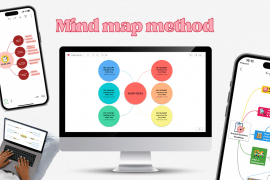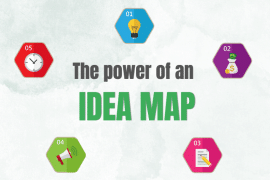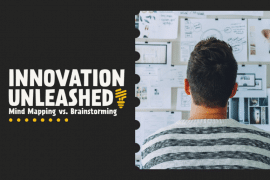
As you are reading this blog, I trust that you are familiar with Mindomo’s Online Mind Map program. It is a great tool. I also suspect that it is not much about the theory behind mind mapping you know. Not to worry. Below I will give a brief intro to the history of mind mapping, some mind mapping rules of thumb, teach you how to utilize both sides of your brain and how to increase your memory by using mind maps.
A brief history of Mindmapping
Nowadays, Tony Buzan is recognized as the guy who took the mind mapping thinking and made it mainstream. But mind mapping stems from a long tradition of alternative thinkers, including Leonardo da Vinci, Albert Einstein and many more.

What they all had in common was their views on the shortcomings of the original pen and paper notes. For them, something had changed. They realized as they began to supplement their notes with drawings, colors, symbols, connecting lines, and assimilations that their ability to memorize and think creatively was enhanced. They were empowered. Only a few of us experienced how our brains thrived when we were forced to think strictly chronologically. The sheer physical composition of our brain is proof of that.
You have two brain parts – Use them
Your brain is made of two parts: the left and the right. Two parts, each with their own abilities. The left is popularly called “the spin-doctor”. The right is called “the artist”.
The spin-doctor likes to tell you how to make sense and think logically about what is going on. A leads to B and then onto C. Not A, B, and C simultaneously. The artist likes to sense feelings, listen to music, and look at the bigger pictures while not being judgmental about what is going on.
If you are driving your car, it is very good to let the logical left part of your brain decide how to act and estimate objects, speed, and size. But if you are staring at a blank sheet, about to start painting a picture, you are thankful that you still have the right part of your brain as well.
Common for both parts is that they function horribly on their own.
Sadly, most educators, schools and universities, do not realize (or at least, they don’t teach accordingly to) this. They are focusing on stimulating the left part of the brain. Read a book. Go to the exam and explain how A leads to B and then C.
Recognizing the need for a diversified approach to learning and collaboration between both parts of your brain can free up immense energy and creativity. Luckily, there are mind mapping advocates like Mindomo that are helping us to change this approach.
Strengthen your memory with these four simple techniques
There are many ways to increase your memory and loads of books claiming to know so as well. To spare you the effort of finding the most effective techniques, I will display four of them that are constantly mentioned and which have also worked well for me. These four techniques are Repetition, Association, Emotion, and Sensing.
- Repetition: The world’s oldest memory technique. Repeating stuff, saying things out loud or reading the same thing over and over again, giving your brain the possibility of confronting the same thing several times, hence increasing the possibility of your brain to remember it more easily. A good first step in memorizing the content in your mind map is therefore to look at it several times. When you are done, go for a walk, have a coffee, do something else, come back and have another look before putting it away.
- Association: Read out loud one of the main keywords of your mind map. Spend a little time thinking when you have confronted with this keyword before. If the keyword is “bicycle”, think about your first bicycle ride. Imagine pictures of yourself riding a bike. Do this for each keyword you inserted in your mind map. Furthermore, you can add keyword-related images to the map, to further strengthen your memory.
- Emotion: When keywords awake your emotions, you conceive and remember them faster. Therefore, it can be an advantage for you to notice the emotions that each keyword brings along, while you are in the repetition process. Taking the “bicycle” example again, the emotion could be the feeling of the sun on your face or the wind blowing as you are riding a bicycle. There are many ways to assign emotions to your mind maps. As you start doing this more often, you will step by step notice how your recollection of the information strengthens.
- Sensing: As a human being you are born with five senses: smelling, tasting, hearing, seeing and touching. Scientists talk about the sixth sense as the ability to read energies and signals. Each of the senses has unique traits that you can use while trying to enhance your memory. If you are trying to remember the keyword “bicycle,” you could use each sense to strengthen your memory. Remember the smell f the oil on the bicycle, the sound of the wheels, the hard saddle, the sore in your muscles after a long uphill climb. I think you get the idea by now. Start activating your senses when you are dealing with different keywords, and they will help you strengthen your memory.
Using one of these approaches to memorize information will get you some of the ways. But, it is only when you make it a habit to run through all of the techniques that your memory is truly enhanced.
You can find an elaboration of these techniques in a mind mapping book by Joyce Wycoff called Mindmapping – Your Personal Guide to Exploring Creativity and Problem-Solving.
Having read the above, please ask yourself the following questions:
- What made Leonardo da Vinci, Albert Einstein and others more creative?
- What are the individual abilities of your left and right brain?
Which of the four techniques you are using to easily memorize information presented in mind map form?
If you know the answer to the above questions, I am sure you will be getting even more out of mind mapping in the future. You can use mind maps for so many things. Note-taking, planning, project management, self-development, memory enhancement, and the list goes on. The one thing that this post aim is to inspire you to investigate further how you can keep empowering your brain by giving it new tools and techniques.
If you have any questions about the above, please post them in the comment section below, and I will be happy to reply.
Steffen Hedebrandt is the founder of Mindmapping.dk . He has been teaching students, university teachers, and other professionals in Denmark about mind mapping and its benefits for the last seven years.







3 Comments
sure, it was free but trying to print out my first mind map was nothing short of a nightmare. upgrading to a paid application might have allowed me to print but no matter what I tried I could not copy, download, or print it. guess I lost a whole morning and ended up with not a very good opinion of Mindomo!
Hi, LaRetta. I’m sorry to hear that Mindomo didn’t meet your needs. The main reason why we are charging for premium features like printing and download is that we are a small company working full time to develop Mindomo. Opposite to other free or freemium tools, most developed as a hobby, Mindomo aims to become the best mind mapping solution, here to stay in the long run.
We have an affiliate program that will let you earn months of premium, you can read more about it here – https://www.mindomo.com/a/account#affiliate-program/win-premium
Please let me know if there is anything I can help you with.
Hey guys,
I hope you find the post valuable.
If you have comments, questions or something else you are very welcome to contact me through twitter:
@SHedebrandt